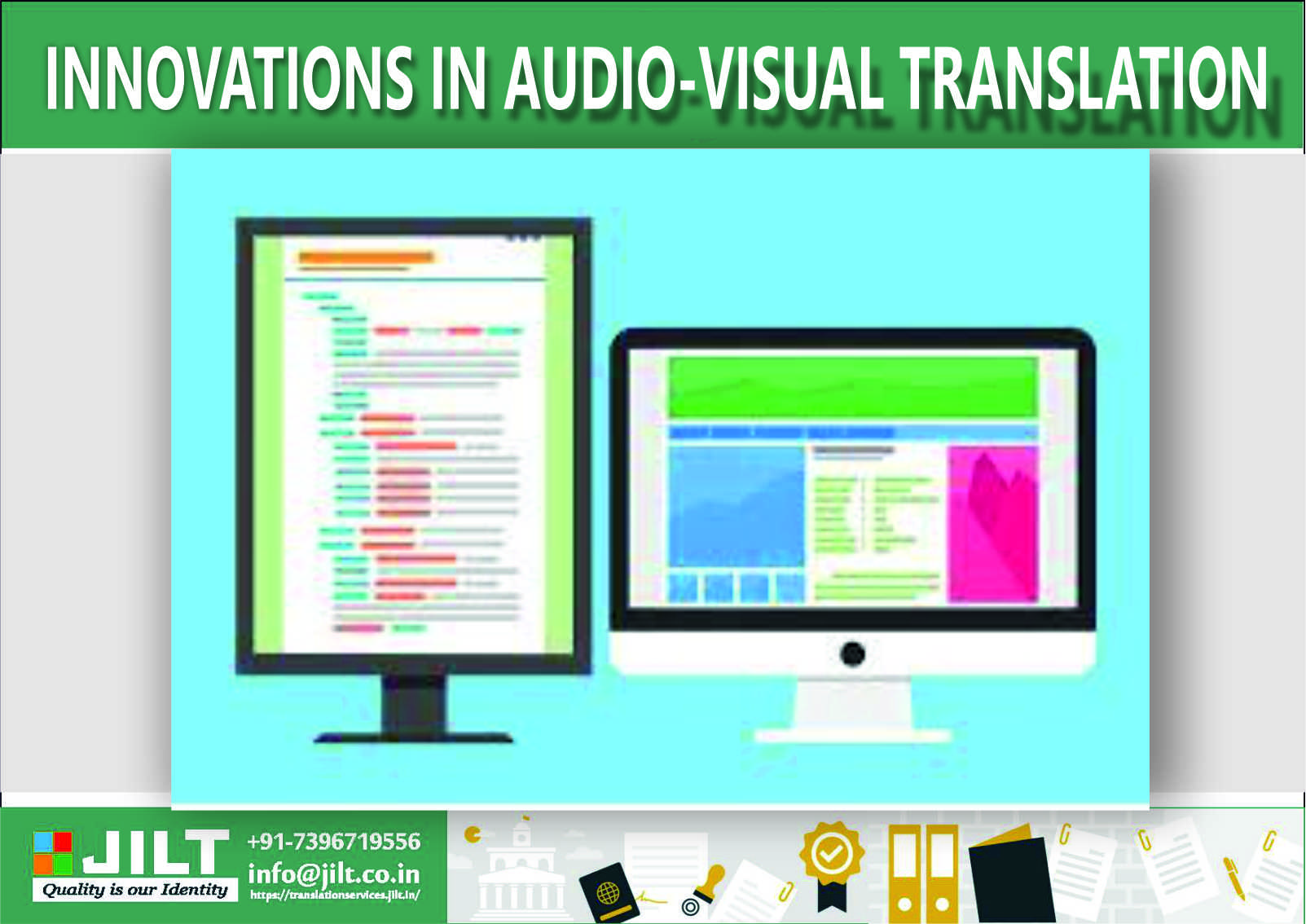
INNOVATIONS IN AUDIO-VISUAL TRANSLATION
by Dr. Abu Mazhar Khalid Siddique - February 21, 2024
The beginnings of audiovisual translation
It is generally agreed that the origins of audiovisual translation may be traced back to the development of silent film. Consequently, this is how the concept of employing actors-interpreters in theaters came about. These individuals would read or perform live dialogues to scenes that were being shown on the screen. It is generally agreed that they were the first people to translate audiovisual content.
It may be difficult to believe, but for almost a century, there has been a significant need for audiovisual translation in the audience market all over the world. In tandem with the evolution of civilization and the advancement of technology, translation methods have also undergone a number of development modifications.
Characteristics of audiovisual translation
Audiovisual translation extends beyond linguistic concerns and requires a unique solution. Understanding and incorporating cultural differences in source texts and recordings is crucial. This unique translation method preserves the original tone, meaning, and cultural background while adapting the information to the audience.
Audiovisual translation must overcome language barriers and capture the source material's culture. You must speak the language and understand the cultural nuances to do this. Multimedia translators understand the complex relationship between language and culture and can convey meaning and expression while remaining authentic to the original.
Understanding the background of the original text or recording is essential for interpretive video translation. Translators work hard to find cultural references, idioms, and sociolinguistic components in language. This enriches the translated material beyond linguistic equivalency.
Keeping the original tone is crucial in audiovisual translation. Translation experts aim to convey the target language's emotional and stylistic qualities. This requires a delicate balance between correct language use and creative alteration to preserve the source material's basic idea while fitting the target audience's culture.
Three audio-visual translation methods are used:
Voiceover: When someone does voiceover, skilled readers read out loud the lines that players say. To give a compelling and true performance, this specialized professional uses a deep knowledge of the script, character dynamics, and emotional nuances. The voiceover reader goes beyond just being a storyteller; they become a conduit for the tone, inflections, and dramatic elements that were meant to be in the original dialogues. Voiceover readers keep viewers interested by blending their voice with the visual material in a way that doesn't seem forced. They do this by using correct pronunciation, intonation, and a deep understanding of the story's background. To improve the total audiovisual experience, voiceover artists need to be good at interpreting, have great language skills, and really understand the characters.
Dubbing : A skilled audio reader carefully interprets and speaks the lines that actors say during dubbing, which is a very complicated process. This level of professional skill goes beyond just translating; it also requires a deep understanding of how characters behave, how emotions affect them, and how the culture affects them. The recording artist tries to time their voice with the actors' lip movements so that the sound and image blend together smoothly. The voiceover reader helps make the dubbed material seem more real because they are good at keeping the original meaning and tone. Dubbing professionals are very important for making sure that different audiences have a good viewing experience by using correct language, intonation, and a strong link to the characters.
Subtitles: When it comes to subtitles, the complicated process includes carefully writing out the actors' lines so that there is no need for a voiceover reader. Professionals who do subtitles have to figure out how to condense speech while still keeping cultural and contextual meaning. When reading quickly and on a small screen, accuracy is very important for getting across the original meaning and tone. Expertise in language, syntax, and pace makes sure that the subtitles go well with the video. As a form of audiovisual translation, subtitling requires a careful balance between language accuracy and viewer understanding. It makes the moviegoing experience more global and open to everyone.
Localization of video games
In order to make a video game suitable for sale in a different nation, the process of localizing it involves making changes and adjustments to the game's original version. In tandem with the expansion of the video game industry, which has become entirely globalized and whose works can be marketed in any place in the globe, there has been an increase in the need for this particular sort of translation. Video game localization is a complicated process, and the degree of complexity involved varies according to the type of video game that is being localized.
Transcription
Language transcription is the careful process of turning spoken material from videos or audio recordings into written text. For this complicated process to work, you need to have a deep understanding of the subtleties of language, cultural references, and the complexities of the spoken conversation. Professional transcribers have a great ear for different accents, languages, and speech patterns, which lets them accurately record the richness of spoken language.
The transcriptionist's job is more than just changing words; they also keep track of meaning by making sure that the nuances, emotions, and emphasis that are communicated verbally are accurately recorded. Paying close attention to details is very important. This includes using correct grammar, figuring out who is speaking, and following style guides. In professional fields like law, medical, or media transcription, reliable and easy-to-find text records can't be made without the help of transcribers. In the end, language transcription is a complex art form that turns spoken words into written ones. This makes it easier to understand, more accessible, and longer-lasting for useful content in many areas.
Direct transcription:
Direct transcription involves carefully turning audio samples into text files that include all of the sounds in one complete file. In this very thorough process, not only is the conversation transcribed, but also unfinished or repeated words, cross-talk, and pronunciation mistakes are included to keep the authenticity of the spoken communication. Expert transcribers get past different speech patterns, accents, and background noises to make sure the final copy is an accurate copy of the original recording. This type of recording is very useful in linguistics, court cases, and qualitative research because it gives a clear picture of the subtleties of spoken language, helps with linguistic analysis, and keeps a full record of what was heard.
Natural transcription:
Natural transcription is a complex process that correctly turns spoken language into written text, capturing the essence of real-life conversation. Unlike verbatim transcription, it includes making the content easier to read while still keeping the meaning. Expert transcribers understand the subtleties of speech, pick up on nuances in the context, and change grammar rules to make a clear and polished written version. People use this type of transcription in market research, the media, and education because it makes records of conversations that are clear and accurate. It's important to provide a copy that not only matches the spoken words but also follows correct grammar rules so that they can be easily understood and analyzed.
PROPERTIES OF A GOOD AUDIOVISUAL TRANSLATOR
- A deep understanding of the source language and the culture that goes with it. The translator needs to understand not only the correct form of the language but also area slang, dialects, and accents.
- Knowing about the history, culture, and daily life of the content's home country in order to get the jokes, cultural references, etc
- A very good grasp of the target tongue. A translator can use all the details that are needed to get the point across in a conversation. One language is usually enough for professional use. That's why translations are usually only done into the translator's first language.
- A lot of different jobs. It doesn't matter if it's a nature documentary, a science fiction show, a horror movie, or a reality TV show. The tone needs to be followed or your audience will be let down.
Challenges in working on audiovisual translation
- Changing the target content: One important thing to remember is that this type of translation is not the same as traditional translation, in which the translator's only job is to accurately translate the material from the source language to the target language.
- Adjusting the length of the translation: Changing how long the translation to the pictures on the screen that change quickly. Keep in mind that people can understand what they hear a lot faster than what they read. People who read subtitles that are too long will not be able to keep up with the changes in scenes and conversation.
- The use of language abbreviation techniques: When translating, you need to use specific methods that let you leave out, shorten, or combine certain parts of speech.
- The ability to divide sections of text: The labels should have no more than two lines of text, and they shouldn't go over that. You need to pick the right style and place the subtitles on the screen correctly.
- Translating colloquial and coarse language: When translating, the person doing the work needs to be able to perfectly match the words used to the situation, the audience's age, and their background.
- Synchronization: For dubbing and voiceover, it's important to make sure that the spoken text matches what's happening in the scene, as well as the players' mouth movements and body language.
In conclusion, audio-visual translation is changing rapidly due to advances. Machine learning and neural networks improve efficiency and accuracy in traditional methods. Immersive technologies like virtual and augmented reality are changing viewer experiences, requiring new translation methods. Additionally, cultural adaptability and nuanced interpretation are crucial to balancing innovation with linguistic and contextual authenticity. The combination of cutting-edge techniques and a strong awareness of cultural differences promises a bright future for audio-visual translation as specialists negotiate this changing landscape.
Our organization employs native-speaking translators who can provide certified translation services in any language. We provide translation services in English (Urdu), Arabic (Spanish), German (French), Persian (Iranian), French (Italian), Japanese (Korean), Russian, and any other Indian or local language. Expert proofreaders at our company will inspect the translation. We also provide a courier service to deliver completed documents to our clients.
- Also Read :- INTERNATIONAL TRANSLATION DAY: BRIDGING CULTURES AND CONNECTING THE WORLD
- Also Read :- Passport translation (JILT - Certified Translation Services)
- Also Read :- BEST PRACTICES FOR PROTECTING DATA PRIVACY IN TRANSLATION
- Also Read :- CRUCIAL FACTORS TO KEEP IN MIND WHEN TRANSLATING LANGUAGES
- Also Read :- WHAT DO YOU MEAN BY LANGUAGE TRANSLATION AND ITS SCOPE?
- Also Read :- Invitation Letter Translation Services
- Also Read :- THE IMPORTANCE OF BIRTH CERTIFICATE TRANSLATION AND ATTESTATION FROM FRENCH TO ENGLISH
- Also Read :- The Importance of Translating Old Revenue Collection Receipts from Urdu to English
- Also Read :- Single-status certificate translations (JILT - Certified Translation Services)
- Also Read :- Statutory declaration translations (JILT - Certified Translation Services)
Search
Categories
Archives by Month
Popular Blog
QUICK TRANSLATION QUOTE
Need help with a translation?
Get in touch with us
Whether you have a specific project you want to discuss, need a translation quote or simply want to discuss your requirements, do not hesitate to get in touch with us.











Social Networks